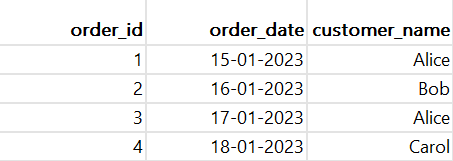Explicit vs Implicit SQL Server Joins
Last Updated :
12 Feb, 2024
SQL Server is a widely used relational database management system (RDBMS) that provides a robust and scalable platform for managing and organizing data. MySQL is an open-source software developed by Oracle Corporation, that provides features for creating, modifying, and querying databases. It utilizes Structured Query Language (SQL) to interact with databases, making it a popular choice for web applications and various software systems. MySQL’s versatility, reliability, and ease of use make it a preferred solution for developers and organizations seeking efficient data management capabilities.
In this article, you will learn about, Explicit vs implicit SQL Server joins.
SQL Joins
A join is a mechanism that combines rows from two or more tables based on a related column between them. The purpose of using joins is to retrieve data from multiple tables in a single result set. The common columns used for joining tables are usually primary and foreign keys.
SQL is divided into explicit and implicit joins based on how the join conditions are specified in the query. In explicit joins, the relationship between tables is explicitly defined using the JOIN keyword along with the ON clause, where the join condition is explicitly stated. This approach provides clarity and readability as the join conditions are visible in the query. On the other hand, implicit joins rely on listing the tables in the FROM clause and specifying the join conditions using the WHERE clause, often using equality operators.

SQL joins
Implicit Join
Also known as traditional or comma-separated joins, implicit joins specify the join condition using the WHERE clause. Tables are listed in the FROM clause, separated by commas, and the join condition is specified in the WHERE clause using equality operators. Implicit joins are considered outdated and less readable compared to explicit joins.
Consider the following database,

Database
Example 1
SELECT orders.order_id, orders.order_date, customers.customer_name
FROM orders, customers
WHERE orders.customer_id = customers.customer_id;
Output:

Example-1 output
Explanation: This output lists the order ID, order date, and customer name for each order in the database. The query combines data from the orders table and the customers table using an implicit join, where the customer_id from the orders table matches the customer_id from the customers table. It displays the order information alongside the corresponding customer names.
Example 2
SELECT orders.order_id, orders.total_amount, customers.city
FROM orders, customers
WHERE orders.customer_id = customers.customer_id
AND customers.city = 'New York';
Output:

Example-2 output
Explanation: This output presents the order ID, total amount, and city for each order placed by customers residing in New York. The query combines data from the orders table and the customers table using an implicit join, similar to the first example. Additionally, it includes an additional condition in the WHERE clause to filter the results, showing only orders from customers located in New York.
Explicit Join
Explicit joins use the JOIN keyword to specify the join condition directly in the ON clause. This approach provides better readability and clarity, as the relationship between tables is explicitly stated in the query. Types of explicit joins include INNER JOIN, LEFT JOIN, RIGHT JOIN, and FULL JOIN.
Consider the following database,

database
Example 1
SELECT employees.employee_name, departments.department_name
FROM employees
JOIN departments ON employees.department_id = departments.department_id;
Output:

Example-1 output
Explanation: This query performs an inner join between the employees and departments tables based on the common department_id column. It returns the employee_name and department_name for each employee along with their corresponding department.
Example 2
SELECT employees.employee_name, departments.department_name
FROM employees
LEFT JOIN departments ON employees.department_id = departments.department_id;
Output:

Example-2 output
Explanation: This query performs a left join between the employees and departments tables, ensuring that all rows from the employees table are included in the result set. If an employee does not belong to any department, the corresponding department_name will be NULL.
Explicit vs Implicit SQL Server Joins
Aspect
|
Explicit Joins
|
Implicit Joins
|
|
Syntax
|
Uses the JOIN keyword with ON clause.
|
Lists tables in the FROM clause, join condition in the WHERE clause.
|
|
Readability
|
Generally more readable and explicit.
|
May be less readable, especially in complex queries.
|
|
Clarity
|
Clearly separates join conditions from other filtering criteria.
|
Mixes join conditions with other filtering criteria.
|
|
Maintenance
|
Easier to maintain and debug.
|
May be harder to maintain, especially in complex queries.
|
|
Types of Joins
|
Supports different types of joins: INNER JOIN, LEFT JOIN, RIGHT JOIN, FULL JOIN, etc.
|
Supports basic join functionality without explicit indication of join type.
|
|
Best Practice
|
Recommended practice for modern SQL development.
|
Considered outdated, but still valid SQL syntax.
|
Conclusion
In conclusion, explicit SQL Server joins, characterized by their use of the `JOIN` keyword with an `ON` clause, offer superior readability, clarity, and maintainability compared to implicit joins. While implicit joins, which list tables in the `FROM` clause and specify join conditions in the `WHERE` clause, remain valid, they are generally considered outdated and may lead to less readable and more error-prone queries, particularly in complex scenarios. Therefore, adopting explicit joins is recommended for modern SQL development, as they provide a clearer separation of join conditions and other filtering criteria, enhancing overall query comprehension and maintenance.
Share your thoughts in the comments
Please Login to comment...